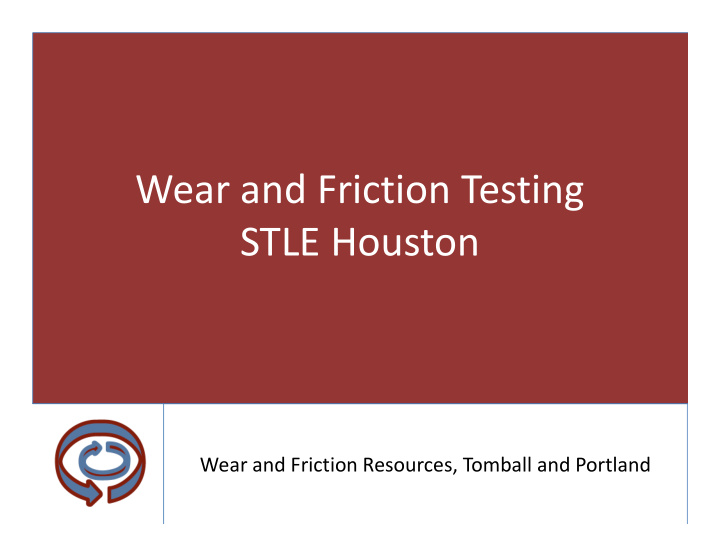



Wear and Friction Testing STLE Houston Wear and Friction Resources, Tomball and Portland
������������ • Used to help select or screen materials for a given application • Controls variables that impossible to control in revenue service • Standardized tests are comparable across different sources • Purpose-built tests include important revenue service parameters
���������������������� • ASTM G65 Dry Sand Rubber Wheel – 50/70 mesh rounded SiO 2 – 30 pound normal force – 60 Shore A rubber wheel – 6000 revolutions – Low stress abrasion
���������������������� • Ability to rank relative wear resistance • Tar sand screening tool • Widely used and accepted • Good correlation with sample hardness
��������
ASTM G65
ASTM G65 • G65 vs. tungsten carbide embedded hardsurfacing
Friction Testing • ASTM G77 block-on- ring
Friction Coefficient
Erosion • ASTM G76: erosion with gas jet – Abrasive medium can be any material that can consistently delivered – Angles between 0 o and 90 o – Particle velocity up to 150 m/sec
Erosion • Factors that affect erosion rates – Velocity – Impingement Angle – Erosive media • Size, shape, hardness – Hardness of surface
Erosion Air foil leading edge Windscreen clouding
Scratch Testing • ASTM G171 – Diamond stylus – 0 to 50 N (11 lbs) – Constant or ramped load – ASTM standard has list of defined damage types (spalling, ploughing, flaking, cracking, etc.)
Scratch Testing • ASTM G171 – ASTM standard has list of defined damage types (spalling, ploughing, flaking, cracking, etc.) – Test metrics include scratch depth and width
Scratch Testing • Modified ASTM G171 scratch test – Well deviation (branching) – Machined edges of casing rubbing against drill string – What type and thickness of a protective coating will protect the drill string?
Scratch Testing
Scratch Testing • M2 tool steel • 4340 heat treated bar
Scratch Testing
Scratch Testing
Scratch Testing • G171 • Thermal spray coating was able to protect the pipe substrate only below certain loads
Scratch Testing
Dragline Bucket Teeth • Problem: the consumable teeth on a dragline bucket lip wear and lose the ability to penetrate; this causes the bucket to slide across the surface rather than “bite” and dig effectively
Dragline Bucket Teeth • The angle-of-attack of the bucket causes a flat wear land on the leading edge of the tooth • The increased surface area decreases the P o and prevent the tooth from penetrating the formation
Dragline Bucket Teeth Solution: apply hardsurfacing to • the highest contact pressure area (bottom of tooth) Hardbanding reduces the wear • rate on the bottom of the tooth Wear on the top of the tooth • causes a continuous self- sharpening edge Since the tooth remains sharp a • greater amount of the tooth volume can be used extending life (from 6 to 72 hours typical)
Wear Testing: Summary • Select test that produces the same wear mechanism as the application • Verify that the surface damage matches service components as closely as possible • Develop relative performances of candidate materials • Correlate testing data with revenue service
Recommend
More recommend